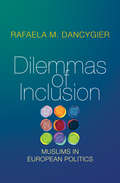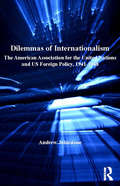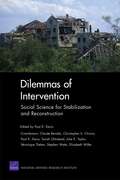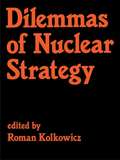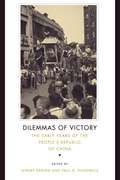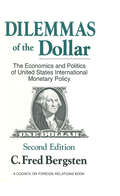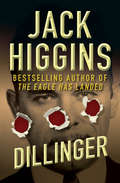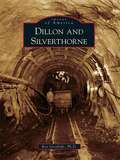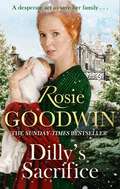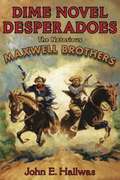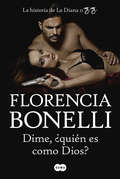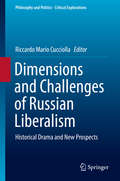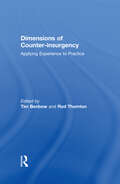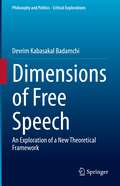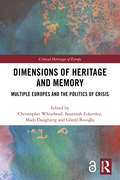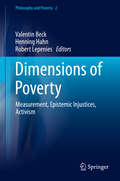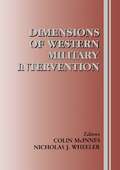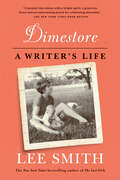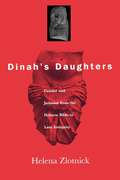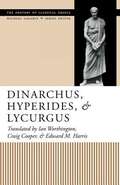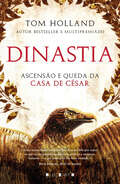- Table View
- List View
Dilemmas of Inclusion: Muslims in European Politics
by Rafaela M. DancygierAs Europe’s Muslim communities continue to grow, so does their impact on electoral politics and the potential for inclusion dilemmas. In vote-rich enclaves, Muslim views on religion, tradition, and gender roles can deviate sharply from those of the majority electorate, generating severe trade-offs for parties seeking to broaden their coalitions. Dilemmas of Inclusion explains when and why European political parties include Muslim candidates and voters, revealing that the ways in which parties recruit this new electorate can have lasting consequences.Drawing on original evidence from thousands of electoral contests in Austria, Belgium, Germany, and Great Britain, Rafaela Dancygier sheds new light on when minority recruitment will match up with existing party positions and uphold electoral alignments and when it will undermine party brands and shake up party systems. She demonstrates that when parties are seduced by the quick delivery of ethno-religious bloc votes, they undercut their ideological coherence, fail to establish programmatic linkages with Muslim voters, and miss their opportunity to build cross-ethnic, class-based coalitions. Dancygier highlights how the politics of minority inclusion can become a testing ground for parties, showing just how far their commitments to equality and diversity will take them when push comes to electoral shove.Providing a unified theoretical framework for understanding the causes and consequences of minority political incorporation, and especially as these pertain to European Muslim populations, Dilemmas of Inclusion advances our knowledge about how ethnic and religious diversity reshapes domestic politics in today’s democracies.
Dilemmas of Internationalism: The American Association for the United Nations and US Foreign Policy, 1941-1948
by Andrew JohnstoneDilemmas of Internationalism is a new political history of the 1940s which charts and analyses the efforts of private internationalists to define US internationalism and promote the establishment of the United Nations. Internationalists hoped that the United States would shake off the fear of entangling alliances that had characterised the nation's history, replacing isolationism and unilateralism with a new, involved and multilateral approach to foreign affairs. During and after World War II, a number of private individuals and organisations were at the forefront of the fight to change the nature of US foreign policy. This book focuses in particular on the most important internationalist organisation: the American Association for the United Nations (AAUN), known as the League of Nations Association through 1944. It situates the AAUN in the vast network of private organisations promoting an internationalist foreign policy during and after World War II, and analyses the connections between the AAUN and the US government and key public figures who proposed a more internationalist foreign policy. One of the most innovative aspects of Dilemmas of Internationalism is its focus on state-private interaction with regard to defining internationalism. Most previous works on wartime internationalism neglect considerations of state-private interaction, or fail to significantly develop them. The study also acts as a corrective to the general neglect of state-private interaction during this period, turning attention away from the common focus on the Cold War to the crucial phase during and immediately after World War II. Beginning with the US entry into the War, this study continues through the onset of the Cold War to early 1948, ending with the passing of the Marshall Plan. By 1948, the path of US internationalism appeared firmly fixed by a Cold War framework, but in 1941, US entry into the Second World War offered the opportunity to develop a more multilateral approach to foreign affairs, and create a more just and peaceful world. This book is a much-needed history of the attempt to seize that opportunity.
Dilemmas of Intervention
by Paul K. DavisGovernments intervening in post-conflict states find themselves beset with numerous challenges and profound dilemmas: It is often unclear how best to proceed because measures that may improve conditions in one respect may undermine them in another. This volume reviews and integrates the scholarly social-science literature relevant to stabilization and reconstruction, with the goal of informing strategic planning at the whole-of-government level.
Dilemmas of Nuclear Strategy
by Roman KolkowiczThis volume reflects the research and discussions for the Bellagio Conference, with a spcial emphasis on the distinct perspective introduced by the Europeans on the issues of superpower strategic relations in general and on MAD and SDI in particular. Their views are shaped by concerns on how these broader issues might affect their own national security interests.
Dilemmas of Victory: The Early Years of the People's Republic of China
by Jeremy Brown Paul G. PickowiczThis illuminating work examines the social, cultural, political, and economic dimensions of the Communist takeover of China. Instead of dwelling on elite politics and policy-making processes, Dilemmas of Victory seeks to understand how the 1949-1953 period was experienced by various groups, including industrialists, filmmakers, ethnic minorities, educators, rural midwives, philanthropists, stand-up comics, and scientists. A stellar group of authors that includes Frederic Wakeman, Elizabeth Perry, Sherman Cochran, Perry Link, Joseph Esherick, and Chen Jian shows that the Communists sometimes achieved a remarkably smooth takeover, yet at other times appeared shockingly incompetent. Shanghai and Beijing experienced it in ways that differed dramatically from Xinjiang, Tibet, and Dalian. Out of necessity, the new regime often showed restraint and flexibility, courting the influential and educated. Furthermore, many policies of the old Nationalist regime were quietly embraced by the new Communist rulers. Based on previously unseen archival documents as well as oral histories, these lively, readable essays provide the fullest picture to date of the early years of the People's Republic, which were far more pluralistic, diverse, and hopeful than the Maoist decades that followed.
Dilemmas of the Dollar: Economics and Politics of United States International Monetary Policy
by C. Fred BergstenAn examination of the role of the dollar in the global financial system which presents a long-term historical perspective on the international monetary system in this century. The main focus is on the evaluation of the global financial system in the post-war period.
Dillinger
by Jack HigginsA novel of the last, desperate days of John Dillinger, America&’s most notorious bank robber. In 1934, after his spectacular jailbreak from a cell in Indiana, John Dillinger was like a ghost—some claimed to spot him in New York, others in London, New Orleans, or California. Though the FBI would eventually find and kill Dillinger in Chicago, speculation about his whereabouts in those mysterious final months never waned. In Jack Higgins&’s suspenseful imagining, Dillinger flees to Mexico, where his attempts at finding freedom launch the fugitive into the clutches of men much more dangerous than the federal agents on his trail. This dramatic account of Dillinger&’s final days brings him face-to-face with bloodthirsty bandits and corrupt police officers, breathing vivid life into the story of America&’s most fascinating outlaw.
Dillon and Silverthorne
by Roy GoodliffeLake Dillon sits at almost 2 miles high in the Rocky Mountains. The dam and reservoir that produced this Summit County resort, along with Dillon Village on its shore and the town of Silverthorne just below it, are collectively one of Colorado's winter-summer fun destinations. Dillon Dam is 5,288 feet long by 231 feet high, creating a large freshwater source for the city of Denver, as well as 25 miles of scenic shoreline. The dam stores 85.5 billion gallons of water from the Snake and Blue Rivers and Ten Mile Creek. On cue, these waters rush eastward to the South Platte River Basin through the Transmontane Project, or Roberts Tunnel--augered hundreds of feet under the Continental Divide in one of the West's most controversial water relocation epics. Today Dillon, Silverthorne, and the Blue River Basin on Colorado's western slope see their share of sailboating, snow and Nordic skiing, windsurfing, and snowboarding.
Dilly's Lass
by Rosie GoodwinYears ago Dilly made the devastating decision to give her baby daughter to wealthy local family, the Farthings. She is still living with the consequences of her choice when the daughter she gave away all those years ago turns up on Dilly's doorstep, with a baby girl in tow, begging for help. Olivia has a secret she only feels safe telling Dilly.Sworn to secrecy, Dilly agrees to help, delighted to be spending time with her new granddaughter and daughter. She can't tell Max Farthing, the man who took in Olivia all those years ago and who Dilly has feelings for. For Max has problems of his own: he's married to Camilla, who has lost leave of her senses. Could Dilly and Max ever come together?Dilly's Lass is a wonderfully heartfelt portrayal of families beginning to rebuild after WW1, from much-loved author Rosie Goodwin.
Dilly's Lass (Dilly's Story #2)
by Rosie GoodwinYears ago Dilly made the devastating decision to give her baby daughter to wealthy local family, the Farthings. She is still living with the consequences of her choice when the daughter she gave away all those years ago turns up on Dilly's doorstep, with a baby girl in tow, begging for help. Olivia has a secret she only feels safe telling Dilly.Sworn to secrecy, Dilly agrees to help, delighted to be spending time with her new granddaughter and daughter. She can't tell Max Farthing, the man who took in Olivia all those years ago and who Dilly has feelings for. For Max has problems of his own: he's married to Camilla, who has lost leave of her senses. Could Dilly and Max ever come together?Dilly's Lass is a wonderfully heartfelt portrayal of families beginning to rebuild after WW1, from much-loved author Rosie Goodwin.
Dilly's Sacrifice: The gripping saga of a mother's love from a much-loved Sunday Times bestselling author (Dilly's Story #1)
by Rosie GoodwinA desperate act to save her family . . .Dilly is devastated: with her husband unable to work and four children already at home, they cannot afford to feed their new-born baby. Heartbroken, she heads into the night to deliver her baby girl to the Farthing family at the big house. Having just lost their own daughter to measles, the Farthings adopt the baby and offer Dilly a lifeline: a job as a maid.This act of desperation will change the lives of both families irrevocably – and the onset of WWI even more so. Sons are taken, love is declared, hearts are broken and terrible acts are committed. Through it all, Dilly does everything she can to preserve her family. But when the chance for true love finally comes, will she choose family over her own happiness?A moving and uplifting story of family, loyalty and love, from much-loved author Rosie Goodwin.
Dime Novel Desperadoes: The Notorious Maxwell Brothers
by John HallwasA thrilling true crime narrative and groundbreaking historical account, Dime Novel Desperadoes recovers the long-forgotten story of Ed and Lon Maxwell, the outlaw brothers from Illinois who once rivaled Jesse and Frank James in national notoriety. Growing up hard as the sons of a struggling tenant farmer, the Maxwell brothers started their lawbreaking as robbers and horse thieves in the 1870s, embarking on a life of crime that quickly captured the public eye. Already made famous locally by newspapers that wanted to dramatize crimes and danger for an eager reading audience, the brothers achieved national prominence in 1881 when they shot and killed Charles and Milton Coleman, Wisconsin lawmen who were trying to apprehend them. Public outrage sparked the largest manhunt for outlaws in American history, involving some twenty posses who pursued the desperadoes in Wisconsin, Minnesota, Iowa, Illinois, Missouri, and Nebraska. Some of the pursuers were intent on a lynching, but the outlaws escaped against incredible odds. When a mob finally succeeded in killing Ed, in broad daylight on a courthouse lawn, that event generated widespread commentary on law and order. Nevertheless, the daring desperadoes were eventually portrayed as heroes in sensationalistic dime novels. A stunning saga of robbery and horse stealing, gunfights and manhunts, murder and mob violence, Dime Novel Desperadoes also delves into the cultural and psychological factors that produced lawbreakers and created a crime wave in the post-Civil War era. By pointing to social inequities, media distortions, and justice system failures, John E. Hallwas reveals the complicity of nineteenth-century culture in the creation of violent criminals. Further, by featuring astute, thought-provoking analysis of the lawbreaker's mindset, this book explores the issue at the heart of humanity's quest for justice: the perpetrator's responsibility for his criminal acts. Every overview and encyclopedia of American outlaws will need to be revised, and the fabled "Wild West" will have to be extended east of the Mississippi River, in response to this riveting chronicle of major American desperadoes who once thrilled the nation but have since escaped historical attention for well over a century. With more than forty illustrations and several maps that bring to life the exciting world of the Maxwell brothers, Dime Novel Desperadoes is a new classic in the annals of American outlawry.
Dime si fue un engaño
by Nieves HidalgoUna vez más, Nieves Hidalgo nos deleita con una novela magníficamente ambientada. Su lectura es una experiencia única, llena de suspense, aventura, acción y un apasionado romance en la Francia Luis XIV. Chantal-Marie vive para vengarse de quien arruinó su vida. Phillip Villiers, vizconde de Basel, convierte su pasión en odio y acaba siendo el temido capitán de Le Missionnaire. Debido a una traición que le hace perder todo cuanto posee y escapar de Francia, Phillip Villiers, vizconde de Basel, quiere olvidar su pasado en la corte francesa, por lo que se convierte en el capitán de Le Missionnaire, temido en las aguas del Caribe. Al mando de aguerridos hombres a quienes no les importa vivir o morir, cree haber pasado página. Hasta que recibe una carta de Damien Moreau, la única personaque sabe que aún vive. Chantal-Marie Boissier vive para vengarse de quien que la chantajeó, arrancó de sus brazos al hombre que amaba, y la arrastró al abismo. Engañar, espiar y tener dudosas amistades no le importa con tal de conseguir las pruebas que lo incriminen. Además, guarda un secreto que nadie puede conocer porque serie su perdición. Pero ni Phillip ha olvidado a la mujer que adoró y sigue adorando, aunque se niegue a admitirlo, ni Chantal puede dejar de lado el recuerdo del hombre por el que hubiera dado su propia vida. Él quiere resarcirse, desconociendo el secreto de Chantal. Ella quiere desquitarse y no está dispuesta a descubrirlo. Y mientras, las intrigas políticas se pasean por la corte de Luis XIV, el Rey Sol.
Dime, ¿quién es como Dios?
by Florencia BonelliUna mujer extraordinaria, que atraviesa la siniestra Guerra de los Balcanes en los años 90 del siglo XX, trata de luchar contra sus fantasmas y encuentra la redención en el amor. Esta historia se cuenta en dos volúmenes: Aquí hay dragones. La historia de La Diana I y Dime, ¿quién es como Dios? La historia de La Diana II. ¿Se puede luchar contra los dragones sin convertirse en uno de ellos? Mariyana Huseinovic, más conocida como La Diana, ha encontrado al amor de su vida, Lazar Kova?, una víctima de abuso sexual y psicológico igual que ella. Juntos han iniciado un camino de sanación. Sin embargo, todavía queda algo pendiente. La Diana necesita cerrar el capítulo más atroz de su vida y recuperar a Larysa, la hija fruto de la violencia, que nació en el campo de concentración de Rogatica, y a quien abandonó cuando ella y su hermana Leila fueron rescatadas de ese infierno por Eliah Al-Saud. El desafío es imponente y dar con la criatura de sus entrañas después de más de cinco años parece imposible. Con la ayuda de Duga Sarajevo, una ONG dedicada a la lucha contra la pedofilia y el tráfico humano, y con el trasfondo de negocios ilegales, políticos corruptos, muertes misteriosas y patentes de semillas cultivables para controlar el alimento en el mundo, La Diana vive el momento más trascendental de su historia, en el que luchará por aniquilar al más feroz de los dragones del pasado y encontrar la posibilidad de ser feliz. Florencia Bonelli, con más de 3 millones de ejemplares vendidos solamente en la Argentina, vuelve a entregarnos su libro más ambicioso, más deseado y esperado por miles y miles de lectoras que la siguen y aguardan sus novedades con expectativa y felicidad.
Dimensions and Challenges of Russian Liberalism: Historical Drama and New Prospects (Philosophy and Politics - Critical Explorations #8)
by Riccardo Mario CucciollaLiberalism in Russia is one of the most complex, multifaced and, indeed, controversial phenomena in the history of political thought. Values and practices traditionally associated with Western liberalism—such as individual freedom, property rights, or the rule of law—have often emerged ambiguously in the Russian historical experience through different dimensions and combinations. Economic and political liberalism have often appeared disjointed, and liberal projects have been shaped by local circumstances, evolved in response to secular challenges and developed within often rapidly-changing institutional and international settings. This third volume of the Reset DOC “Russia Workshop” collects a selection of the Dimensions and Challenges of Russian Liberalism conference proceedings, providing a broad set of insights into the Russian liberal experience through a dialogue between past and present, and intellectual and empirical contextualization, involving historians, jurists, political scientists and theorists. The first part focuses on the Imperial period, analyzing the political philosophy and peculiarities of pre-revolutionary Russian liberalism, its relations with the rule of law (Pravovoe Gosudarstvo), and its institutionalization within the Constitutional Democratic Party (Kadets). The second part focuses on Soviet times, when liberal undercurrents emerged under the surface of the official Marxist-Leninist ideology. After Stalin’s death, the “thaw intelligentsia” of Soviet dissidents and human rights defenders represented a new liberal dimension in late Soviet history, while the reforms of Gorbachev’s “New Thinking” became a substitute for liberalism in the final decade of the USSR. The third part focuses on the “time of troubles” under the Yeltsin presidency, and assesses the impact of liberal values and ethics, the bureaucratic difficulties in adapting to change, and the paradoxes of liberal reforms during the transition to post-Soviet Russia. Despite Russian liberals having begun to draw lessons from previous failures, their project was severely challenged by the rise of Vladimir Putin. Hence, the fourth part focuses on the 2000s, when the liberal alternative in Russian politics confronted the ascendance of Putin, surviving in parts of Russian culture and in the mindset of technocrats and “system liberals”. Today, however, the Russian liberal project faces the limits of reform cycles of public administration, suffers from a lack of federalist attitude in politics and is externally challenged from an illiberal world order. All this asks us to consider: what is the likelihood of a “reboot” of Russian liberalism?
Dimensions of Counter-insurgency: Applying Experience to Practice
by Tim Benbow and Rod ThorntonThe once-neglected study of counter-insurgency operations has recently emerged as an area of central concern for Western governments and their military organizations. While counter-insurgency represents a hugely challenging form of contemporary warfare, there exists a considerable body of experience that offers assistance in the form of examples of
Dimensions of Development
by Susan VincentDimensions of Development traces the 'development' of Allpachico, a village in the Peruvian central highlands. Susan Vincent examines four aid projects in the area, each following distinct international trends, that took place between 1984 and 2008 within the context of wider state and global political and economic systems.A unique historical ethnography, Dimensions of Development illustrates how state and NGO projects have drawn Allpachiqueños deeper into capitalism and have brought about challenges to the local political structure, the comunidad campesina. While highlighting the continual reorganization of the local population into new groups, Vincent also reveals why the comunidad remains the group's preferred form of representation.
Dimensions of Free Speech: An Exploration of a New Theoretical Framework (Philosophy and Politics - Critical Explorations #19)
by Devrim Kabasakal BadamchiThis book offers a new theoretical framework for free speech by critically analyzing the major justifications for free speech. Unlike most theories that justify free speech on single grounds, this book argues for a justification; namely the double grounded principled approach; that combines and revises the arguments of equal autonomy and democratic participation at the same time. It claims that a revised and critical blending of these two justifications can serve free speech to be grounded on strong principled arguments. The book has both a theoretical and practical focus: first, it discusses the conceptual circumstances of free speech and major theoretical justifications for free speech and then, it applies the developed theoretical framework to the cases of academic freedom, media freedom and hate speech separately. This volume will appeal to readers who are interested in general free speech theories as well as readers who look for an alternative view on specific topics such as academic freedom, media freedom and hate speech.
Dimensions of Heritage and Memory: Multiple Europes and the Politics of Crisis (Critical Heritages of Europe)
by Christopher Whitehead Susannah Eckersley Mads Daugbjerg Gönül BozoğluDimensions of Heritage and Memory is a landmark contribution on the politics of the past in Europe today. The book explores the meanings of heritage in a time of crisis, when the past permeates social and political divisions, identity contests and official projects to forge a European community. Providing an overview of the literature and an analysis of the assumptions, values and philosophies embedded within European-level policy, the book explores different dimensions of heritage and memory, from official sites, museums and policy, to party politics, historical re-enactments and the everyday ways in which people use the past to make sense of who they are. The volume explores how different understandings of and attachments to the European past produce different ‘Europes’ in the present, accounting for today’s tense social and political relations. The book also explores formative histories for European identities that are neglected or hidden because of political circumstances and non-official heritage. Contributors consider the meanings of interlocking crises, such as economic fallout, xenophobia and the fragmentation of the EU, for new understandings of Europe’s past in the present. Dimensions of Heritage and Memory will be of great interest to researchers, academics and postgraduate students in the fields of heritage and memory studies, museum studies, history, cultural studies, sociology, anthropology and politics. The book will also be interesting to practitioners and cultural heritage policy-makers.
Dimensions of Poverty: Measurement, Epistemic Injustices, Activism (Philosophy and Poverty #2)
by Valentin Beck Henning Hahn Robert LepeniesThis anthology constitutes an important contribution to the interdisciplinary debate on poverty measurement and alleviation. Absolute and relative poverty—both within and across state boundaries—are standardly measured and evaluated in monetary terms. However, poverty researchers have highlighted the shortfalls of one-dimensional monetary metrics. A new consensus is emerging that effectively addressing poverty requires a nuanced understanding of poverty as a relational phenomenon involving deprivations in multiple dimensions, including health, standard of living, education and political participation. This volume advances the debate on poverty by providing a forum for philosophers and empirical researchers. It combines philosophically sound analysis and genuinely global research on poverty's social embeddedness. Next to an introduction to this interdisciplinary field—which links Practical Philosophy, Development Economics, Political Science, and Sociology—it contains articles by leading international experts and early career scholars. The contributors analyse the concept of poverty, detail its multiple dimensions, reveal epistemic injustices in poverty research, and reflect on the challenges of poverty-related social activism. The unifying theme connecting this volume's contributions is that poverty must be understood as a multidimensional and socially relational phenomenon, and that this insight can enhance our efforts to measure and alleviate poverty.
Dimensions of Western Military Intervention
by Nicholas J. Wheeler Colin McINNESMilitary intervention to protect civilians in danger has emerged as a key challenge for the West. This book explores the West's reaction to these challenges and some of the limits on its actions.
Dimestore: A Writer's Life
by Lee Smith“A memoir that shines with a bright spirit, a generous heart and an entertaining knack for celebrating absurdity.”—The New York Times Book Review“This is Smith at her finest.”—Library Journal, starred review Set deep in the mountains of Virginia, the Grundy of Lee Smith’s youth was a place of coal miners, tent revivals, mountain music, drive-in theaters, and her daddy’s dimestore. When she was sent off to college to gain some “culture,” she understood that perhaps the richest culture she would ever know was the one she was leaving. Lee Smith’s fiction has always lived and breathed with the rhythms and people of the Appalachian South. But never before has she written her own story. Dimestore’s fifteen essays are crushingly honest, wise and perceptive, and superbly entertaining. Together, they create an inspiring story of the birth of a writer and a poignant look at a way of life that has all but vanished.
Dinah's Daughters
by Helena ZlotnickThe status of women in the ancient Judaism of the Hebrew Bible and Rabbinic texts has long been a contested issue. What does being a Jewess entail in antiquity? Men in ancient Jewish culture are defined primarily by what duties they are expected to perform, the course of action that they take. The Jewess, in contrast, is bound by stricture.Writing on the formation and transformation of the ideology of female Jewishness in the ancient world, Zlotnick places her treatment in a broad, comparative, Mediterranean context, bringing in parallels from Greek and Roman sources. Drawing on episodes from the Hebrew Bible and on Midrashic, Mishnaic, and Talmudic texts, she pays particular attention to the ways in which they attempt to determine the boundaries of communal affiliation through real and perceived differences between Israelites, or Jews, on one hand and non-Israelites, or Gentiles, on the other.Women are often associated in the sources with the forbidden, and foreign women are endowed with a curious freedom of action and choice that is hardly ever shared by their Jewish counterparts. Delilah, for instance, is one of the most autonomous women in the Bible, appearing without patronymic or family ties. She also brings disaster. Dinah, the Jewess, by contrast, becomes an agent of self-destruction when she goes out to mingle with gentile female friends. In ancient Judaism the lessons of such tales were applied as rules to sustain membership in the family, the clan, and the community.While Zlotnick's central project is to untangle the challenges of sex, gender, and the formation of national identity in antiquity, her book is also a remarkable study of intertextual relations within the Jewish literary tradition.
Dinarchus, Hyperides, and Lycurgus
by Ian Worthington Edward M. Harris Craig R. CooperThis is the fifth volume in the Oratory of Classical Greece. This series presents all of the surviving speeches from the late fifth and fourth centuries B.C. in new translations prepared by classical scholars who are at the forefront of the discipline. These translations are especially designed for the needs and interests of today's undergraduates, Greekless scholars in other disciplines, and the general public. Classical oratory is an invaluable resource for the study of ancient Greek life and culture. The speeches offer evidence on Greek moral views, social and economic conditions, political and social ideology, law and legal procedure, and other aspects of Athenian culture that have been largely ignored: women and family life, slavery, and religion, to name just a few. This volume combines the surviving speeches of three orators who stand at the end of the classical period. Dinarchus was not an Athenian, but he was called on to write speeches in connection with a corruption scandal (the Harpalus affair) that put an end to the career of Demosthenes. His speeches thus raise many of the vital issues surrounding the Macedonian conquest of Athens and the final years of Athenian democracy. Hyperides was an important public figure who was involved in many of the events described by Dinarchus and Lycurgus. His speeches open a window into many interesting facets of Athenian life. Lycurgus was one of the leading politicians in Athens during the reign of Alexander the Great and put Athenian public finances on a more secure footing. He was also a deeply religious man, who tried to revive Athenian patriotism after the crushing defeat at Chaeronea.
Dinastia: Ascensão e Queda da Casa de César
by Tom HollandO retrato da família que transformou o Império Romano para sempre. Primeiro governada por reis, Roma tornar-se-ia uma república. Mas no fim, após conquistar o mundo, a república desmoronou-se. Roma afogou-se em sangue. As guerras civis foram tão terríveis, que o povo romano acolheu de bom grado o governo de um autocrata que lhes poderia dar a paz. «Augusto», o seu novo senhor, intitulava-se «O Divino Favorito». O fantástico esplendor da dinastia fundada por Augusto nunca esmoreceu. Nenhuma outra família se compara em fascínio com a sua galeria de personagens: Tibério, o grande general que acabou os seus dias como um recluso amargurado, célebre pelas suas perversões; Calígula, o mestre da crueldade e humilhação; Agripina, a mãe de Nero, cujas manobras levaram o filho ao poder, e que acabaria por morrer por ordem dele; Nero, que pontapeou a mulher grávida até à morte, que se casou com um eunuco, e que ergueu um palácio de prazer no centro dos escombros de uma Roma destruída pelo fogo.
